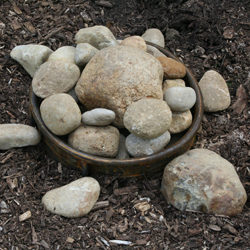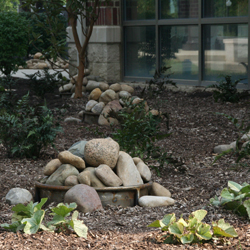Here Come the Turtles
by Matthew Williams
 If you have been wondering, “What’s up with this pile of rocks? And what’s this mulch for?” as you walk along the Olentangy Recreation Trail past the Harrison Park Condos Community Center, you finally have your answer: the Turtle Bed.
If you have been wondering, “What’s up with this pile of rocks? And what’s this mulch for?” as you walk along the Olentangy Recreation Trail past the Harrison Park Condos Community Center, you finally have your answer: the Turtle Bed.
Hoping to save some of the rocks that have dotted the Harrison Park site for, well, millennia, I tried to come up with a use for as many as I could. Ideas weren’t forthcoming, though, until I became fascinated by the turtles—some as large as 18 inches in diameter, others as small as a silver dollar—that began crawling up (or down, in the case of the little guy) the riverbank in May and early June. When I discovered several caches of translucent white spheres at the top of the bank, I realized that the larger turtles were females laying eggs. How fun would it be, I thought, to use the rocks I’d been fretting about in some kind of turtle sculpture to acknowledge that this is their home, too?
When I suggested my idea to my partner, Mark, he grabbed a piece of paper and sketched up an arrangement of nine turtle “statues” to be scattered among the plantings in the semi-circular flower bed that is crowned by the Riparian sculpture. I liked it. We would “sculpt” rock piles, which would resemble the fractured look of a turtle shell, and use additional rocks for heads, tails and flippers. The problem of maintaining the shape of the turtles, though, quickly stuck out its head. How could we keep the piles from disintegrating into just so many more rocks among the heads and tails? We could use an epoxy to glue the body rocks together, but part of the appeal of Mark’s idea was that the sculpture would change over time. Animals and kids would move or remove some rocks, and we’d replace them with other rocks. That’s when the idea for the steel rings struck. Rigid rings would provide a mold to hold the turtle shells’ shapes without fixing the turtles into unalterable forms. A few long spikes on the rings would anchor them in the ground, and we’d have just what we needed.

Early in the summer, I called Steve Bush, my CCAD buddy who oversaw the students participating in our art competition, to run our idea past him, and he was all on board for making the steel forms. (Steve told me later, though, that he didn’t really “get” what we were up to until he saw the final sculpture; so much for being the chair of the communications committee!) I spent several afternoons during the summer scavenging for the most unique and beautiful rock specimens, and 15 or so wheelbarrow loads later, I had what I hoped would be enough rocks. Mark and I developed a planting plan including a magnolia, pulmonaria, ferns, and three snowberries (which have yet to be installed because they’re currently unavailable). Our thought is that in the summer, the ferns and pulmonaria will largely hide the turtles, but in the winter, the rock sculptures will reemerge to remind us that in only a few months, real turtles would again be climbing up the bank. We refined our proposal with Maureen Lorenz from Recreation and Parks and ran it by Bob Mangia, the Society Parks Committee Chair, and Rob Harris, the Society President; they loved it and gave us the green light immediately.
The mulch was a happy accident. In June, when we received 400 or so daylilies for the park, we planted up the flowerbeds at the recreation path entrances and in the triangle-shaped bed on Harrison Park Place. The daylilies would not survive, though, without mulch to hold in some of the ground moisture, so we called Maureen and asked if we could get some for those beds. She agreed, and the city brought over a truckload. Fortunately, a truckload was more than we needed for those three small beds. (You probably saw the leftover piles disappear from West Second Avenue and Quality Place a few weeks after the daylilies arrived.) I dragged out Bob’s wheelbarrow, which has been living in my back yard all summer, and moved the leftovers to the patio at the rec. center where I’d been saving the rocks.
 Finally, just days before the Harrison Park Grand Opening on September 1, Steve dropped off the turtle forms, and Mark, Matt Wolf, two borrowed sledgehammers and I were able to set the forms and build the turtles. Picking though the pile of rocks to find just the right head or the flat, crescent-shaped stones that look like flippers was great art therapy for Mark and me; we’d had to put our dog down just that morning. The day before the grand opening, our landscapers came out to plant the greenery and spread the mulch. We have a few rocks left that we’ll find a home for before it snows, but now, we’re just anxious to see how the plants interact with the turtles next spring and to watch the turtles evolve. We hope you are, too.
Finally, just days before the Harrison Park Grand Opening on September 1, Steve dropped off the turtle forms, and Mark, Matt Wolf, two borrowed sledgehammers and I were able to set the forms and build the turtles. Picking though the pile of rocks to find just the right head or the flat, crescent-shaped stones that look like flippers was great art therapy for Mark and me; we’d had to put our dog down just that morning. The day before the grand opening, our landscapers came out to plant the greenery and spread the mulch. We have a few rocks left that we’ll find a home for before it snows, but now, we’re just anxious to see how the plants interact with the turtles next spring and to watch the turtles evolve. We hope you are, too.


 September 6, 2011
September 6, 2011 







One Response to “Here Come the Turtles”